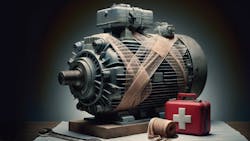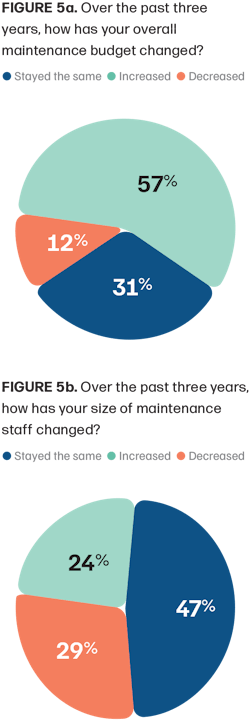4 factors impacting electric motor maintenance, according to plant professionals
Last spring the Electrical Apparatus Service Association (EASA) partnered with Plant Services to survey our readers, the plant maintenance professionals, on a range of topics that centered on maintenance practices and decision making when it comes to electric motors.
EASA is the international association that serves and represents companies in the electric motor, pump, and rotating apparatus repair service and sales industry. The spring 2023 survey on plant maintenance decision-making generated more than 250 responses from plant professionals across a range of job titles and industry verticals.
The survey focused on four areas: (1) plant maintenance priorities; (2) maintenance outsourcing trends; (3) sustainability practices relating to electric motors including motor efficiency, reliability, and recycling; and (4) considerations for determining when electric motors should be repaired or replaced.
This article reviews the highlights from this research project, combining a summary of key data points with analysis from two industry experts – Ron Widup and Justin Hatfield – who are also longtime EASA members.
1. Plant maintenance priorities
With dozens of tasks and distractions that compete for the attention of plant professionals, the first section of the survey sought to identify workers’ current top priorities, and then examine whether they had changed much over the last 10 years.
Figure 1 shows which goals are considered current top priorities. When respondents’ top three choices are considered in aggregate, the top priority that emerges is “reducing equipment downtime” by a wide margin, followed by “labor cost reduction” and “energy savings.” (It is worth noting that, when respondents’ No. 1 choice is considered in isolation, “improving productivity/output” and “improving safety” move into the No. 2 and No. 3 positions from previous industry research data.)
When the 2023 data are compared against the two previous surveys conducted by EASA on this topic (see Figure 2), a pattern emerges where top priority goals have stayed consistent over the past 10 years, with the top three priorities staying the same over that period and merely switching places a bit. The pattern is maintained closely for both middle-tier and bottom-tier priorities.
Lastly, the survey asked what the current hot-button issues were for plant professionals, and Figure 3 shows that “supply chain challenges and delays” continue to be top of mind, followed closely by “hiring and retaining employees” and “energy efficiency/reduction.”
Ron’s take
When you think about people that have responsibility for plant maintenance and operations, their big charge is to is to keep the place running reliably and safely. That's always going to be up there on the list and where we saw those 1-2-3 reducing downtime and safety, it validates that it’s for sure always top of mind. When you think about why that is, or what would you do to reduce downtime, it goes back to the basic things that we've seen year-over-year as we do these surveys: a need for continuous training and education, especially for newer folks coming into the workforce. Regular preventive and predictive maintenance also is a big factor to reducing downtime. The survey didn’t focus on artificial intelligence so much, but when it comes to actual intelligence, actual intelligence is knowing what your equipment is doing and monitoring the condition so you can take appropriate actions to enhance safety and reliability. That's a big part of it and that's a big part of reducing downtime.
Another thing we see a lot is that many of our customers, who have the best performance characteristics, have a pretty effective strategy for uptime and keeping things going. They've got a robust set of spares inventory, especially for critical assets. If you have something fail, you want to be able to replace the defective component right away with a spare and not wait on the turnaround time from an outside vendor or internal repair resources. When you do have a failure it's also very important to perform a root cause failure analysis to figure out: (1) why did it fail; and (2) what are we going to do to keep that from happening again? That's a great strategy to employ, and supply chain issues of late are making it an even a bigger issue.
Justin’s take
I think everyone in the EASA world has dealt with those challenges of supply chain, although it has gotten better than what it probably was, where it hit a peak six months to a year ago. It has improved significantly, but there's still a lot of lingering effects, no matter if it's a certain bearing or a certain brush. Some projects of ours have waited 16, 20, 30 weeks, just ridiculous lead times for parts that used to be readily available, so there’s been a shift where it's been an important thing to pay attention to and make sure you're prepared for events, and not relying just on vendors to get things done in a quicker time frame.
2. Maintenance outsourcing trends
In an age where hiring and retaining employees is a hot-button issue for most facilities, the second section of the survey addressed the kinds of work that plant teams are able to keep in-house as well as the work they send to outside support to execute that work.
Figure 4 is a list of 20 different maintenance practices, presented in order of the most-outsourced types of work to the least-outsourced types. The types of work at the top of the list are all types of work where it could be cost-prohibitive to keep expert technicians on site with the associated specialty equipment and shop space: service and repair of electric motors, hoist cranes, drives and controls, and switchgear, as well as oil/lubrication testing.
In sum, 4 out of 5 respondents are likely to outsource electric motor service and repair, and nearly half of respondents are outsourcing pump service and repair. At the bottom of the list are the work types that teams feel comfortable performing in house, including motor testing, equipment alignment, root cause failure analysis, and several flavors of predictive maintenance.
In an associated question, respondents were asked if the size of their budgets and their maintenance staff has changed (see Figure 5). Interestingly, budgets seem to have increased, but team sizes have in general stayed the same.
Justin’s take
When there's an emergency or a crisis, it's amazing how facilities find money to get things done. Not that it’s the best approach! I still think there's a lot of challenges in industrial facilities to get non-breakdown money, to get money for planned things. It's almost a daily battle where people want to do things and they can't just because the higher ups in the company won't give them the money to get it done. But when something breaks, it's amazing the checkbook they can find.
With maintenance budgets, I think some of that is related to the supply chain data we already talked about, where people were paying extra to rush things in because they had no options, and they had no choice but to spend more money on air freight, and ask vendors how quickly can they get it done. It’s related to the first section which identified downtime as the main issue teams are dealing with, and you can't do that unless you're spending money. The people that have been really smart in this have started to prepare so they're not caught in this middle ground in the future.
The data on outsourcing trends speaks to what we see in the marketplace, that it is very rare to see people do electric motor service or repair within their own facilities now. There are plenty of facilities that in emergencies will do a quick bearing change or something like that, but I think motors just by the nature of what they are don't have a home in a lot of organizations. You have electrical people and you have mechanical people, but motors are electro-mechanical, so who takes the lead? Think of degrees – electrical engineering, mechanical engineering – electro-mechanical typically isn't there, so I think it’s natural for them to outsource more to shops that are focused on the entire motor, both sides, electrical and mechanical.
Ron’s take
One of the things that we found that has been very beneficial, and we most often see it with our larger customers, is that if there's a hybrid approach where they partner with their local service provider or group, that group also can also provide additional training and education with their folks on how to do basic motor testing and maintenance and other key best practice methods for safety and reliability.
3. Energy efficiency and sustainability practices
The last two survey categories focus on one specific technology class – industrial motors – and explore how industry perceives reliability and efficiency as it relates to motor technologies.
The first question asked respondents about how reliable they consider motors that are repaired according to industry standards, especially in comparison with a new motor, and the data were revealing (see Figure 6). Over the past 10 years, the number of respondents who don’t see a difference in reliability has gone steadily up, and the number which believe that new motors have better reliability has gone steadily down.
When the topic turns to motor efficiency (see Figure 7), nearly half of respondents believe that repaired motors generally operate at the same level of energy efficiency as before. Furthermore, these opinions have not changed significantly over the past 10 years. In fact, the number of people who believe that repaired motors (i.e., repaired according to industry standards) exhibit a higher level of energy efficiency than before has gone steadily up.
Justin's take
Reliability is definitely the number one priority that people care about, to get something running. I think that it's becoming less frequent that someone is asking for a more efficient motor because a lot of motors have been replaced over time, especially when you're talking about smaller horsepower (10-50 hp), those are being replaced a lot.
EASA has done a lot of great work to prove that if you follow best practices, that the motor will maintain its efficiency standard if you repair it to the EASA standard, which is called AR-100 (also available at easa.com for download). In fact an EASA rewind study tested the efficiency of motors, from new from the manufacturer versus the same motors then went out and got repaired to the EASA AR-100 standard, and the study found no efficiency change in the motor.
One thing I always find interesting is, does the same person managing motor replacement also pay the energy bill? Because if there's a different person paying the bill, they probably don't care as much about the energy efficiency of a given motor. You're really going to be able to see energy savings when you look at variable frequency drives and process changes, because if the motor is manually or mechanically valving or dampening, that’s wasted energy. With a VFD you slow the motor down, and create an output that is needed for the process. A lot of that's been done in the last 5-10 years, and there's definitely still plenty of opportunities for improvement.
Ron’s take
If you think about the guy or gal in the plant, whether it's a paper mill or steel mill, or maybe a manufacturing facility, just as we saw in previous survey questions, they are worried about the quality of the product. They tend to not be worried so much about the efficiency of the motor, so often those programs don't tend to make it to the maintenance crews for buy-in. If there were internal incentives for management, maintenance, and production to figure it all out together, I think facilities would be surprised at what they could get their people to do if they get them talking to each other more!
4. Best practices for motors repair or replace
The final section of the survey addressed an evergreen question in industry: what is the right balance to strike between industrial motor repair and replacement. EASA research has tracked responses to this question over the past decade, and Figure 8 reveals a significant upward trend in the number of respondents (27%) who have seen an increase in the number of motors being repaired. The data show a similar drop in the number of respondents (20%) who say they are repairing fewer motors than they were two years ago.
In a separate question, 66% of survey respondents admitted that they make decisions on electric motor repair/replacement decisions are likely made on a case-by-case basis. However, the survey also revealed patterns to how those decisions are made, with 43% of respondents automatically buy a replacement motor if the repair cost is an average 53% or higher of the replacement cost (see Figure 9). Also, only one in four respondents have a policy of automatically replacing failed electric motors that fall below a specific rating, and those with a policy use 30 hp as their average cut-off point.
Ron's take
When I saw this part of the survey, it made me think about a recent failure scenario that happened to me: I had a tire that went flat on my truck in the middle of a freeway in Dallas. The tires were pretty new, but I caught a nail in one, and of course it was a model had been discontinued, so I had to buy a replacement tire that’s a little bit different from the dealer tire. When that happens it’s not a good idea to buy just one tire that’s different, you have to buy two.
I think those same sentiments often happen with electric motor repairs. If you have a motor where everything lines up and fits just like it’s supposed to when you need to repair or replace it, and the spare is an identical unit, you don't have to worry about adaptability or modification to any external components. Having assurances that repair or replacement can be done efficiently without much re-engineering, and you’ve done what you’re supposed to do and have an identical spare, you can put your spare in, send the failed motor to the shop, and now you don't have installation issues.
Cost will always be a factor, and supply chain issues have been a big factor in recent years – we just haven't been able to get some of the motors lately. And here’s an often overlooked aspect of repairing electric motors by your local service provider: we’re some of the greenest folks you could have out there because we're recycling just about everything when it comes to electric motors – the copper, the steel, the bearings, all of that. When you put all these factors together, it just oftentimes makes more sense to repair versus replace. It's a motor-by-motor decision, but lately it sure seems to be a more viable trend to repair versus replace.
Justin's take
If there are sustainability approaches for an organization, repair can play a big role instead of disposing of that motor. I also think there's a factor here of inflation where there have been some drastic increases of new motor price, sometimes 30-40-50% price increases. So if supply chain keeps you from getting the right motor, and they're more expensive, you’re going to end up repairing the one you have.
Ron made a good point about direct replacement of units as well. Motor connection box locations have changed a lot over the years. Where there used to be the traditional side-mounted location (called F1 or F2), a lot of motor manufacturers have switched to a more global design where the connection box may still end up on the right side or the left side, but it now may come out the top and then is manipulated to be F1 or F2. If you have conduit cemented in, that can sometimes give issues on where you can put a motor, so repairing it gives a is a lot easier option many times because it's less headaches.
I think people have gone through those headaches where they replaced a motor and said, hey, give me the newest up-to-date efficient one. Then it comes in and it doesn't fit in the application, and they don't want to deal with all those things again. They'd rather even pay a little more to have it repaired in order to not have the headaches that happen with it, especially if the repair is done by a qualified provider, which is what the data are telling us.
About the Author

Thomas Wilk
editor in chief
Thomas Wilk joined Plant Services as editor in chief in 2014. Previously, Wilk was content strategist / mobile media manager at Panduit. Prior to Panduit, Tom was lead editor for Battelle Memorial Institute's Environmental Restoration team, and taught business and technical writing at Ohio State University for eight years. Tom holds a BA from the University of Illinois and an MA from Ohio State University
Ron Widup
Ron Widup is the Vice Chairman, Board of Directors, and Senior Advisor, Technical Services for Shermco Industries and has been with Shermco since 1983. He is a member of the NETA Board of Directors and Standards Review Council; a Principal member of the Technical Committee on Standard for Electrical Safety in the Workplace (NFPA 70E); Principal member of the National Electrical Code (NFPA 70) Code Panel 11; Principal member and Chairman of the Technical Committee on Standard for Competency of Third-Party Evaluation Bodies (NFPA 790); Principal member and Chairman of the Technical Committee on Recommended Practice and Procedures for Unlabeled Electrical Equipment Evaluation (NFPA 791); a Principal member of the Technical Committee Standard for Electrical Equipment Maintenance (NFPA 70B); and Chair of IEEE Std. P902 (Yellow Book) Recommended Practice for Maintenance and Operational Safety of Electrical Power Distribution Systems in Industrial and Commercial Facilities. He is Chairman of the Texas State Technical College System (TSTC) Board of Regents, a NETA Certified Level 4 Senior Test Technician, State of Texas Journeyman Electrician, a Senior Member of the IEEE Standards Association, and an NFPA Certified Electrical Safety Compliance Professional (CESCP).
Justin Hatfield
Justin Hatfield, CMRP, CRL, is the President of HECO out of Kalamazoo, MI. He also serves as Chairman of EASA’s Emerging Technologies Committee and a member of EASA’s Marketing and Industry Awareness Committee.









